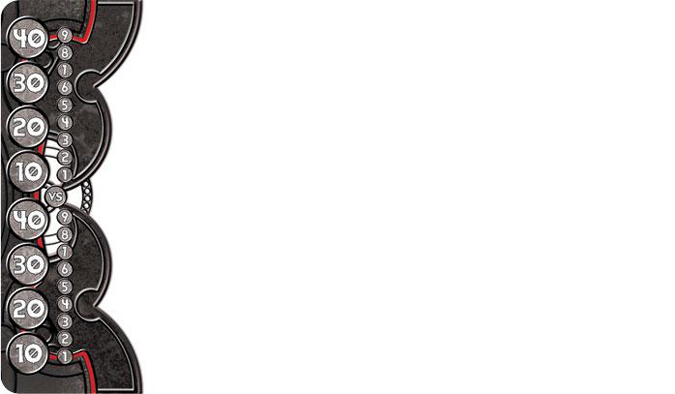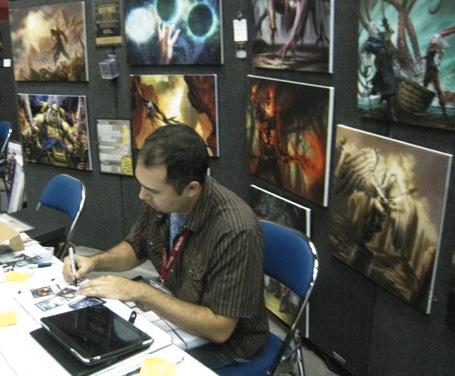Another how-to guide, yayyyyy!
I’m not fond of them either, dear reader, but I’m preparing for a convention and figured this will help me remember everything, and it might be of value to you as well. As most conventions are similar, writing to all y’all works in this capacity, finding a nugget that’s directly usable. As to why I’m writing this seemingly again:
My previous article “Convention Tips & Tricks for the Artist” would be a good primer if you are an artist. A year and a half ago, I talked of the four Ps of marketing: product, price, placement, and promotion. Today, we’ll be touching on the three Cs of brand management and some other advice to keep in mind.
I am off to Spectrum Live 2 in a few short days, and the convention is quite unique to our Magic landscape. It’s a convention that focuses solely on art and is inclusive to all mediums. It has a ton of Magic artists and short lines, and very, very few Magic players show up. The link below has a list of all the artists exhibiting at a booth.

I will be reporting live. My Twitter feed @VorthosMike might have a bunch of information all weekend. And by might, I’ll be blowing up like you thought I would. Just saying, when I find deals or, well, an artist offers something crazy-inexpensive, I’ll be yelling.
Artists, you’re first.
For Artists
Let’s talk convention prep with a lens. Rather than just spouting opinions and then arguing with Twitter pundits, Kenichi Ohmae’s model of the three Cs to be successful in business will be a great focusing point for out little convention primer. The Cs are customer, competitors, and company.
Strategy isn’t action, but without a full MBA in your back pocket, years of outside, varied experience, and consultants, any advice that can be plugged and played or adapted is valuable.
As an added bonus, I contacted artists RK Post and Dan Scott to give some insight into preparing for a convention. You’ll see their answers mixed in. They’re both fantastic and will both be at Spectrum Live. I’ll be sure to say “hello” to both.
 |
 |
1. The Customer
In this C, you will focus on the actual person. Artists, your customers are the key drivers of your marketing strategic plan. The concept of patronage is long dead, but long-term customers are surely still around. People want to buy stuff from you because your art isn’t easily available on them internets at Target.
How do you study the market of both your customers and potential customers?
Well, you have three modes of purchase: online, offline at home, and at a convention. Divide them up, and start looking at any data you have.
How is your marketing coverage for each of them? How are you detailing the data? Are you writing down who the people are who buy your stuff? If not, why not?
The phrase, “I can’t recall who bought this original artwork,” needs to go away. Selfishly, I would like to do future art exhibitions on Imaginative Realism (a.k.a. fantasy and science fiction art). From the community’s perspective, highlighting quality art moves the illustration art world forward. If we have no records, how can we show provenance and put on shows? Don’t you want to contact collectors who have bought your art to see if they’d like another? That’s the easiest sell ever: “Hi, I know we haven’t talked much, but I know you bought my previous artwork. How is that treating you?” Listen intently, and then, “Would you be interested in a new work I made?”
That’s an e-mail and an easy one at that.
I’m not asking if every artist proof transaction is tracked. I’m talking about making a database list of all interested people who buy prints, on up to original art.
A print is a small investment. Adding a person to a mailing list or something that automatically lets them know when new art is in your online store, blog, Etsy, or Facebook is good for business.
You can then find more repeat customers. When new art is spoiled, you can gauge interest on what pieces to make more prints of and what original art to list at a higher price.
If you have a list, you can poll your audience and give them a Survey Monkey questionnaire. Imagine a survey during a convention on your booth’s table. That increases the dwell time during which they are at your booth, thus increasing sales.
In addition, the hits from announcing this on Facebook, in e-mails, and on Twitter before the convention will create buzz, and the cost of a few artist proofs are very, very much worth it. Magic players always want to be heard. Wizards of the Coast regularly sends out voluntary surveys on new Magic sets with individual cards to rate. The community is used to this. Ping them!
You might not think so, but many other artists (your competitors) are studying the market. A periodic market study is necessary to ensure the continued effectiveness of your marketing strategy.
2. The Competitors
“It's either my life or your life. And I ain't leaving, I like breathing.” That’s an eloquent statement by Andre Romelle Young and a very real image that should stick with you.
The freelance life is a hustle, sure. But don’t make it harder for yourself by shooting yourself in the foot because you haven’t stepped back and thought about your business objectively.
Sales
How are sales? Study and learn from them. I mentioned how important knowing your customer is from a data standpoint. Sales are just completed data points. I’d be more interested in how many people added a poster or print to your online store’s checkout but didn’t complete the order. Think about why they would do that. (It’s usually shipping costs, but not always.)
If you don’t have time, contact your local college, especially an entrepreneurial department at a business school for help. I guarantee they’ll be open to looking at data and helping to optimize. Arts management programs are gaining steam and constantly need practical experiences in the field. A classroom capstone (final project) is ideal, but just having an intern study your Profit & Loss (P&L) sheets as well as checking your cost of goods (COGs) is just netting you longer-term profits.
Sometimes, we just need to swallow our ego to gain a more stable business.
Purchasing
A point-of-sale (POS) analysis can do wonders. When they’re seconds from the purchase from you, what customers think about is so incredibly interesting. I mentioned how shipping could be a deal breaker—what if you had a cookie on your website when a returning user who didn’t complete a transaction would be given a popup prompt saying, “I notice you like my ‘Forest from Mirage’ but haven’t picked it up yet. I’d love for you to enjoy my art. Let me know how to help.” That opens a dialogue, just like the chat popups from car dealerships to DirecTV.
At conventions, minor improvements can lower the variance of conventions due to the upfront costs. If you can be relatively sure you’ll be able to net $50 to $100 more per day from minor improvements, you need to do them. For example, adding a sign when you’re in the bathroom with a unique offering: “If you retweet this tweet [link], I’ll honor a discount on a single print by 20%.” You might sell more prints, it might not matter, but it’s a stage where people are trying to purchase, and they just need a tiny incentive to wait until you’re back. Tiny, tiny incentives work because no one else does them.
The basic foundation you have to ask is, How easy is it to buy something from you? If online, a customer has two Internet windows open—yours and another artist’s—and both of you have illustrated planeswalkers, and his store is a lot easier to navigate, what will happen?
If you’re sitting across from RK Post, and his cost for sketches is the price of the proof and an extra $5 to $10, a secondary item to bring a purchase up to a $20 bill is quite easy. Keep in mind that Magic players will be seeing ATMs, so $20s are the magical number. Getting to $20 or $40 is ideal.
Making a list of things on purchasing to understand is vital. Articulating why and adjusting is what competitors will teach you. Your cost of prints, play mats, sketches, artist proofs, and original art will change over time. If your prices are open to negotiate, this will also change. If taking a print down $2 each to move a dozen more over the life of a con is a choice, the marginal lost cause is gained by novelty and a feel good discount for consumers. Information on pricing smaller works such as artist proofs or prints are rarely discussed. Seriously.
If a sale is losing its grip, do you have backup plans?
- I would have payment plans in hand, written and solid, that you use.
- I would also offer to ship prints or art. An offer is nice, but proving that you’ve done it and that it’s worked out is even better.
- I would absolutely be sure of your supply chain and remaining numbers of everything. Be like Randy post:

Randy with a massive fan’s collection of his art at Grand Prix: San Diego 2011.
Hope the fan bought an artist proof.
Do you have other play mats for sale?
- Can you beat twenty-five play mats for $300? If not, go to InkedPlaymats.
- If you don’t have a local printer: I’m all for the local business, but if it isn’t apparent that there is one, or worse, they’re crazy-expensive, take Randy Post’s advice:
Having a pile of white play mats available for altering is just wise and an inexpensive offering. Just remember that you might have to ship them out. I’d add the $8 to $15 of shipping into the cost, but that’s just me. I’m partial to the play mats with extra stuff on them—but that are still essentially white—such as CoolStuffInc’s ones with the life counter on the side

Servicing
Study the strengths and weaknesses of how other artists use online strategies, and measure their performance against your own.
How do you measure this? Ask them.
Better yet, ask people on Twitter, Facebook, and Reddit. Magic players will tell you. I guarantee it.
Some of the important factors you will need to analyze are web functionalities such as an online store, an online purchase experience like John Avon’s or Terese Nielsen’s prints at StarCityGames, and online customer support (how you respond to questions and issues). Be available on Twitter and Facebook. You can barely respond, but when people tweet at you, it pops up into your e-mail.
It’s hard to make the jump that other artists are while competing for the same collectors and Magic player dollars since artists have no control over which card art will be on which card—or even the strength of the card!
Think about it this way: If you’re mindful of the customer already and have looked at what your competition is, testing out different concepts of fulfilling orders and why purchases are made will cause the sales to come naturally if you aren’t a hermit.
3. The Corporation or Company
Artists, you have to have a plan for your business, and conventions are a very visible marketing effort. You need goals to leverage your unique aspects and strengths during each and every convention. You can predict demand and prepare for it.
That’s a nice business-school piece of meaningless advice for you, but here’s something to bite into: Use planogram planning at your next convention.
What’s a planogram?
A planogram is a diagram or model that indicates the placement of retail products on shelves in order to maximize sales.
In other words: Make your convention space shoppable.

They don’t need to be beautiful plans—just functional.
You are a business; understand how you portray your products in the market—a convention—it’s enormously important but often overlooked.
Ever wonder why some items are on the end cap at Target or why some toys are at a child’s eye level? Everyone knows this is meticulously planned, right?
Not a single website has market research on what should go where on a table at a convention. Here’s some quick advice.
Promote trade-up – Showcase original art, lithographs, and canvas prints on the top area to encourage trading-up from artist proofs and open run prints. If you have them vertically aligned, even better.
If you have an artist friend next to your booth, set art that “goes together” on the edges of your tables. Make it an even cost as well: This plus that equals $20.
Create a pattern – Block your artworks on the wall behind you. When a piece sells, you better have a backup artwork to place on the wall, and also, you’d better know how a sold piece changes the flow of your space.
Watch visitors come up to your booth. Do people approach from the left or right? You better believe that if it’s by the left side, your booth should flow from left to right, having eye-catching pieces on the left.
Emphasize bestsellers – Sell your core artworks higher on the wall. You’re a goblin guy? That Goblin King better go on top. A new set just came out: Dragon’s Maze. Your new artwork that depicts your style and brand best should be on display.
If you’re near the end of a hallway, whatever corner of your booth is closest to should have a marquee piece. Is it a tournament staple that you’ve heard a lot about? Is it a piece people ask you about often? Are you “known” by a piece? Place that artwork in the top-right corner, even if the original has sold. I would recommend making a framed print, perhaps a lithograph even, to fit that space.

Like this, but with art.
Is there plenty more to talk about? Of course.
This is just a primer, a tidbit of information.
One day, GatheringMagic.com will put out a book for new artists. Maybe an artist will write it and we’ll publish it for them. We shall see.
For Magic Players
- The only thing you need to know about learning how to enjoy art at a convention, Grand Prix, or otherwise is to please be prepared. Waiting from the last day of GenCon to pick up play sets of signatures seems like mind-numbingly obviously bad idea, but so few players plan early. Preparing for the art aspects of a convention has dates to keep in mind.
- That’s difficult to know apparently, so I made a little timeline for all y’all.
Four Months Prior and Earlier
- Do you want your favorite artists to be invited to events? Get in touch with your tournament organizers, and make suggestions for who would be great to come. Do you have a Legacy scene? Get some Brainstorm artists visiting. A large Modern presence changes the list, and so on. Tournament organizers have a good pulse on things, but selecting artists is an imperfect process.
Three Months Prior
- Start budgeting for art. Some people will able to simply set aside a small amount each month, but the vast majority of us should start selling some Magic—bulk stuff mainly—to have some funds available for the convention.
- Contact the artist if you wish to do a payment plan for an original artwork. $100 a month with the final payment in person isn’t that difficult on the budget. (We have $500-plus decks; c’mon.)
One Month Prior
- Look at your Commander decks. If an artist is going to be at the convention, make a note of which cards you’d like to have signed or get foiled out before the convention.
- Oh, the artist list isn’t confirmed yet? Talk to the TO and start yelling about who will be there. Be a fan boy or fan girl. You might not think so, but artists need to be advertised. If it isn’t widely known, advertise for the artist. Tag him or her in Facebook statuses, add his or her Twitter handle to tweets . . . all these efforts are noticed and appreciated.
From Dan Scott:
- Help the artists out. If they don’t do well at your city, they might decline in the future. Don’t let that happen.
- You know your short list of cards you wish to have signed? You should start buying those cards on eBay, at Coolstuffinc.com, and so on. Trading weeks before largely isn’t worth your time. Finish off play sets for signing.
One Week Prior
- You should have all the cards you wish to have signed.
- Stop contacting artists—they’re probably in pre-con mode now, hustling to get ready. Please don’t bug them right now unless you have a very solid relationship with one.
- Contact the artist to confirm he or she will bring the art you have on a payment plan and find out how he or she would recommend you bring it home (bubble wrap and cardboard or whatnot). Find out if it’s possible to have certificate of authenticity on the back of an artist proof. Be very cordial.
One to Three Days Prior (Depending on Travel Time)—the Last Day at Your House
- Set aside your cards to be signed. Place them in a separate plastic case; do not keep them in your binder. When there’s a line, don’t be the guy who needs ten minutes to get all the cards ready. If your cards are in a deck, plan to do it ASAP after an event or the morning of the convention.
The Convention, Day 1
- Stop by, and say “hello.” Have your cards signed when there’s a short line or no line at all. You can also drop your cards off with a tip if you can wait a day or two.
- Buy an original artwork straight out of the gate. It helps an artist’s entire weekend to know the hard costs are covered ASAP. Seriously, they love that shib.
- Do not put drinks on the artist’s booth table. Do not place your backpack on it either. Bad things happen, and artists have no real way to recoup costs if Funyun dust or a Big Gulp ruins their wares.
- Pick up your original artwork paid with a payment plan beforehand, with the final payment in hand. If the artist has everything prepped, cool. If not, just touch base, and say you’ll be back. I will be actually picking up an original art day one at Spectrum Live—really.
- A Dan Scott piece of advice:

The Convention, Final Day
- Pick up your original art if the piece is a major Magic artwork. Ask the artist if having it on the wall behind him is beneficial to his brand. For example, if the artwork was a Spectrum-included artwork and the convention is Spectrum Live, wait until the last day.
- If you’re at a Grand Prix and a card stood out as new and underutilized but it did well, pick up art for it. Buy an artist proof from an artist for Commander at the very least. They could sell out quickly.
One Day After
- Send a quick thank-you note to the artist. Join his or her Facebook art page and drop a status or send a quick tweet to the artist—something of that sort would be nice.
- Hook your friends up with their cards. Be very, very fast about it. They can then contact the artist ASAP, which you will urge.
One Week After
- If you plan on heading to another convention soon, touch base with an artist or group of artists to ask about their scheduling.
One Month After
- If you bought an original artwork that is not framed, please send the artist an image of the final image. As much as the artists say they don’t care, it matters, and it’s a nice thought.
I hope you found something you could use.
I surely remembered a few things to keep in mind.
Thanks to Dan and Randy. I appreciate it, and I’ll see you soon.


























